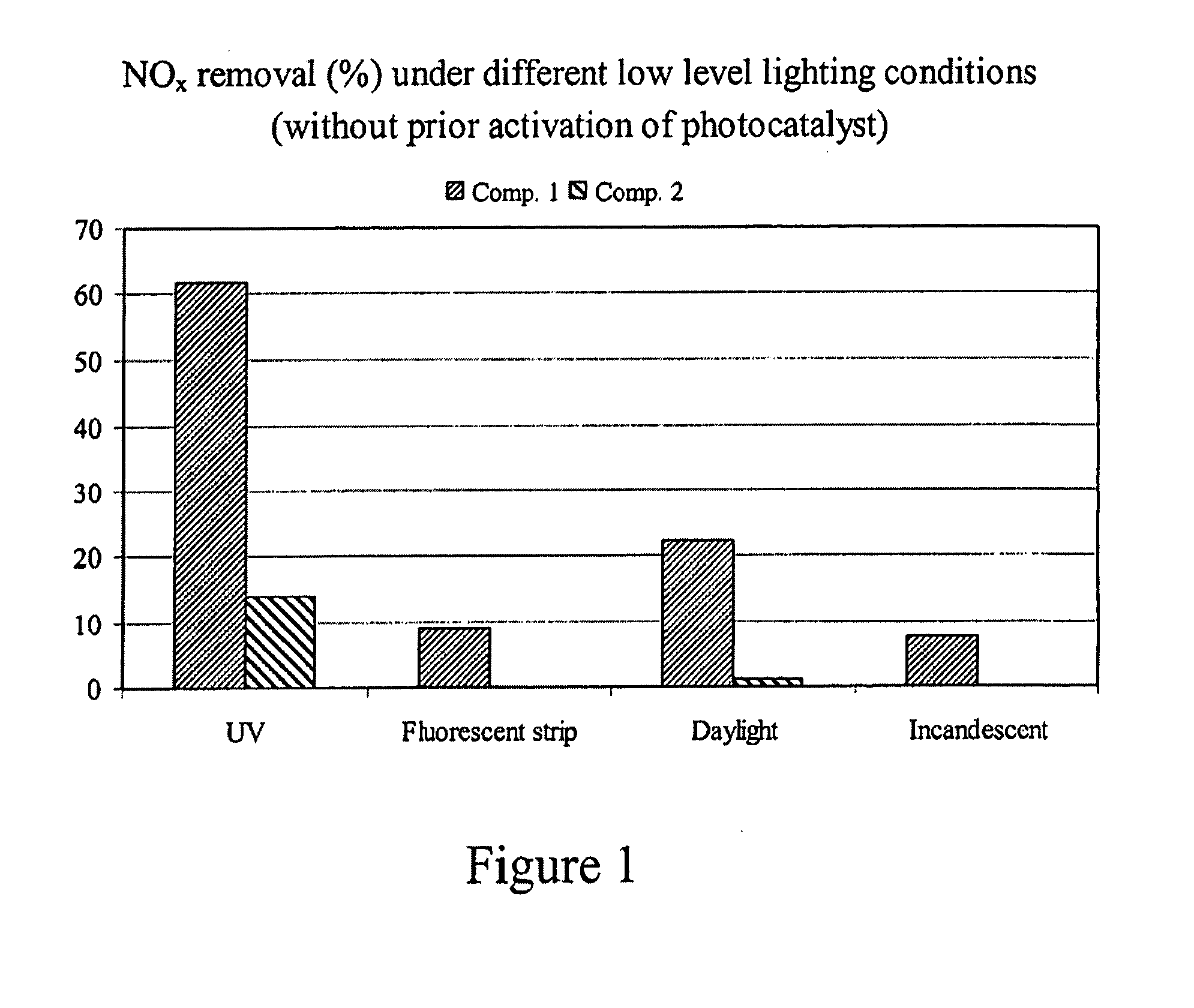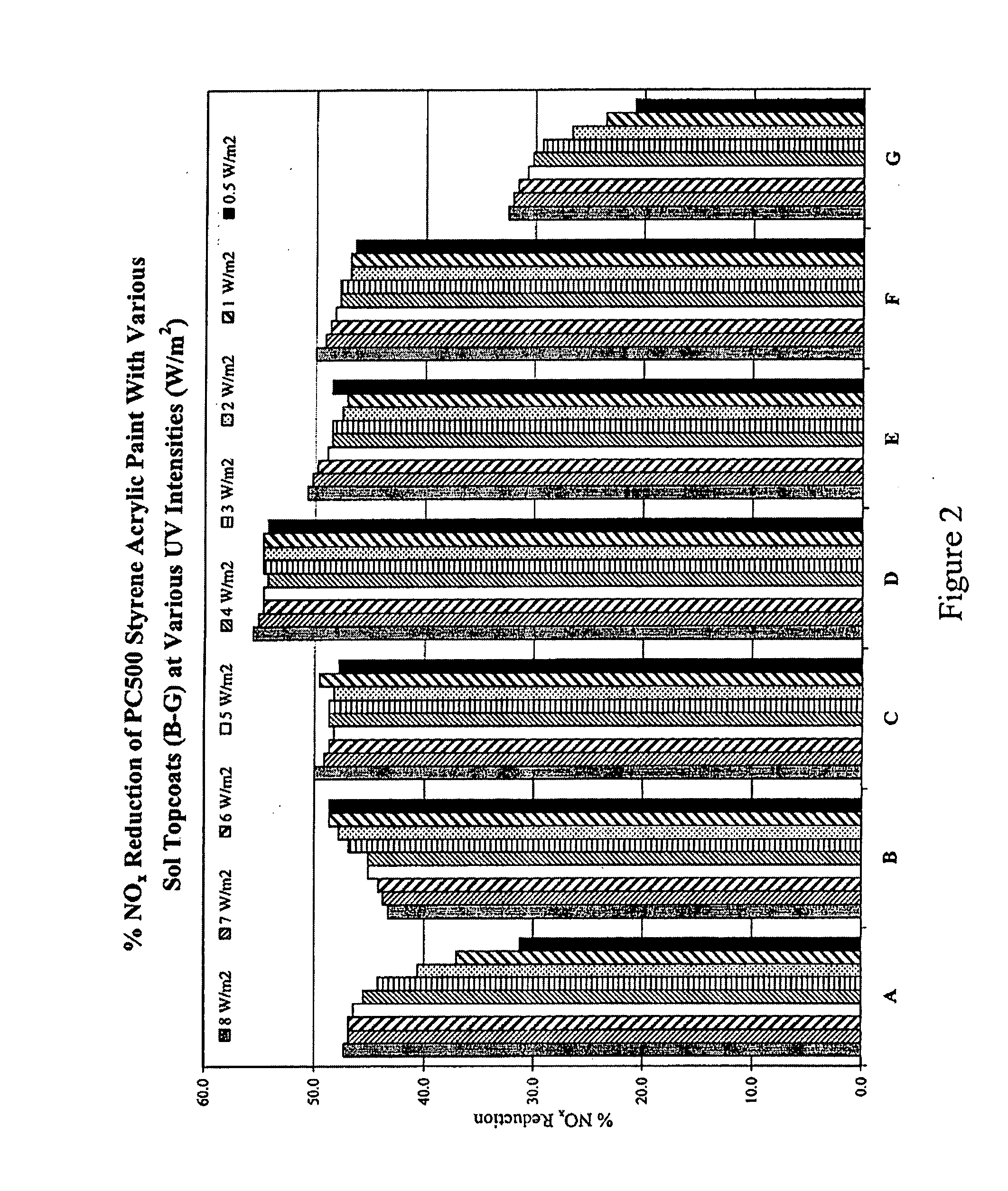Photocatalytic Coating
a photocatalytic coating and titanium dioxide technology, applied in the direction of catalyst activation/preparation, chemical/physical processes, synthetic resin layered products, etc., can solve the problems of difficult to provide photocatalytic coatings with high levels of photocatalyst, inconvenient application of poor initial activity of conventional photocatalytic titanium dioxide coatings, etc., to achieve the effect of reducing nox compounds
- Summary
- Abstract
- Description
- Claims
- Application Information
AI Technical Summary
Benefits of technology
Problems solved by technology
Method used
Image
Examples
example 1
[0033]The ability of the inventive coatings to remove NOx pollutants, its self-cleaning properties, and its durability was investigated by preparing three water-based styrene acrylic paints. Comparative samples “Comp. 1” and “Comp. 2” each comprised 10% photocatalytic titanium dioxide by volume, whereas no photocatalyst was present in the control sample. The photocatalytic titanium dioxide used in Comp. 1 was PCS300 from Millennium Inorganic Chemicals. PCS300 is a photocatalytic titanium dioxide powder having an average crystallite size of about 5 to about 10 nm (nanometers). The photocatalytic titanium dioxide used in Comp. 2 was PC105, also from Millennium Inorganic Chemicals, which has an average crystallite size of about 15-25 nm. PCS300 and PC105 both have an anatase content of about 100%. The complete paint formulations are provided in Table 1.
TABLE 1Comp. 1Comp. 2ControlIngredientFunctionWeight (g)Part AWatersolvent159.94159.94152.41Natrosol 250MRthickener99.3099.30104.64Foam...
example 2
[0055]While paints having photocatalyst crystallite sizes between about 5 and about 15 nm represent a preferred embodiment of the invention, including, for example, the paint designated Comp. 1 in Example 1 having a photocatalytic TiO2 particle size of about 5-10 nm, the benefits of high PVC (pigment volume concentration) achievable through the use of a styrene acrylic binder are also seen, albeit more modestly, with less preferred titanium dioxide crystallite sizes (i.e., about 15 to about 50 nm). For example, paints employing high levels of PC105 photocatalyst (about 15 nm to about 25 nm crystallite size) will also find utility in coatings for removing NOx.
[0056]This example illustrates the efficacy of the paint designated Comp. 2 in Example 1 in removing pollutants under “real world” conditions. A corner of a parking garage was sealed off by constructing two walls to provide a 917 m3 closed area with a ceiling height of 2.85 m. The 322 m2 ceiling surface was coated with the Comp....
example 3
[0061]A styrene acrylic paint was prepared substantially as described in Example 1 except that PCS300 was replaced with a comparable 100% anatase photocatalytic titanium dioxide powder available from Millennium Inorganic Chemicals under the trade designation PC500. PC500 has a surface area of about 300 m2 / g which translates to an average crystallite size of about 5 to about 10 nm. PC500 was included in the paint at a level of 8% by volume and the styrene acrylic binder comprised about 50% by volume. The ability of this paint to remove NOx without prior activation was studied as a function of UV intensity across a range of intensities from 0.5 W / m2 to 8 W / m2 according to the procedure described above in Example 1. The results are given in Table 8.
TABLE 8UV intensity(W / m2)% NOx reduction0.531.3137.1240.6344.2445.5546.4646.9746.9847.3
[0062]These results demonstrate that even at very low UV intensities, the inventive paints provide high removal of pollutants, even without pre-activation...
PUM
| Property | Measurement | Unit |
|---|---|---|
| crystallite size | aaaaa | aaaaa |
| crystallite size | aaaaa | aaaaa |
| crystallite size | aaaaa | aaaaa |
Abstract
Description
Claims
Application Information
 Login to View More
Login to View More - R&D
- Intellectual Property
- Life Sciences
- Materials
- Tech Scout
- Unparalleled Data Quality
- Higher Quality Content
- 60% Fewer Hallucinations
Browse by: Latest US Patents, China's latest patents, Technical Efficacy Thesaurus, Application Domain, Technology Topic, Popular Technical Reports.
© 2025 PatSnap. All rights reserved.Legal|Privacy policy|Modern Slavery Act Transparency Statement|Sitemap|About US| Contact US: help@patsnap.com


